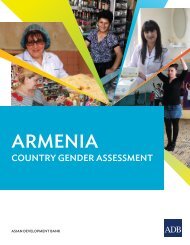Civic Activism as a Novel Component of Armenian Civil Society
English-3
English-3
You also want an ePaper? Increase the reach of your titles
YUMPU automatically turns print PDFs into web optimized ePapers that Google loves.
activists are being targeted through social network information campaigns. Unfortunately, we<br />
have no single datab<strong>as</strong>e that would contain information on both the use <strong>of</strong> social media and<br />
activism, and hence, we are unable to directly compare these two elements. ARMedia h<strong>as</strong> data<br />
on the use <strong>of</strong> social networks but no data on activism, while the WVS h<strong>as</strong> data on activism but<br />
not on use <strong>of</strong> social networks. To enable us to combine these two types <strong>of</strong> information, we<br />
operationalise this information using standard variables that can be compared. We use b<strong>as</strong>ic<br />
socio-demographic variables, age, gender, education and income, to depict a ‘typical <strong>Armenian</strong><br />
social network user’ and compare that socio-demographic portrait with a ‘typical <strong>Armenian</strong><br />
political activist’ to determine whether there is a match between these two groups. Settlement<br />
type is included in the analysis <strong>of</strong> Internet use but not in the analysis <strong>of</strong> activism because the<br />
WVS does not have a comparable variable.<br />
4.2.1. On the Receiving End <strong>of</strong> Online Information<br />
As we demonstrated in the descriptive section <strong>of</strong> this chapter, Internet usage is on the rise in<br />
Armenia. Assuming that civic initiatives rely on the Internet, and particularly on social media, to<br />
spread information about their activities and mobilise support, who are the people on the<br />
receiving end <strong>of</strong> civic initiatives’ information campaigns? To understand this, we ran a number<br />
<strong>of</strong> statistical tests with the standard socio-demographic variables (age, gender, education, income<br />
and settlement type) and four <strong>of</strong> the variables described above: Internet use, trust in online<br />
information sources (online publications and social networking cites in particular), and frequency<br />
<strong>of</strong> social networking cite use to gain information about current events and news. We conducted<br />
tests for the years 2011 and 2013. Unless specified otherwise, we report the results <strong>of</strong> statistical<br />
tests for the year 2013 only, while discussing a pattern that applies to both years, to avoid<br />
burdening the chapter with too many numbers.<br />
Age: Younger people use the Internet more. The average age <strong>of</strong> those who report using<br />
the Internet in the p<strong>as</strong>t 12 months is 38, compared with an average age <strong>of</strong> 56 for non-users for the<br />
year 2013; this difference is statistically significant. 7 Nearly one-third (27%) <strong>of</strong> those who<br />
reported having used the Internet in the p<strong>as</strong>t 12 months are between 25 and 34 years old; another<br />
23% come from the 15-24 age cohort. Thus, people up to 34 years old account for half <strong>of</strong> the<br />
Internet users for the year 2013. There is a statistically significant correlation between age on the<br />
one hand and trust in both online media 8 and social networks 9 <strong>as</strong> sources <strong>of</strong> information on the<br />
other: younger people are more trustful. The pattern is very clear and runs steadily through age<br />
cohorts, <strong>as</strong> depicted in Figure 4. Younger people are also more frequent users <strong>of</strong> social<br />
networking cites <strong>as</strong> a source <strong>of</strong> information about current events. 10<br />
7 T-test: t(1397) = -20.997, p < 0.001 for year 2013.<br />
8 Pearson’s correlation: r = -0.274, N = 677, p < 0.001 for year 2013.<br />
9 Pearson’s correlation: r = -0.283, N = 647, p < 0.001 for year 2013.<br />
10 Pearson’s correlation: r = 0.527, N = 1383, p < 0.001 for year 2013.<br />
28



